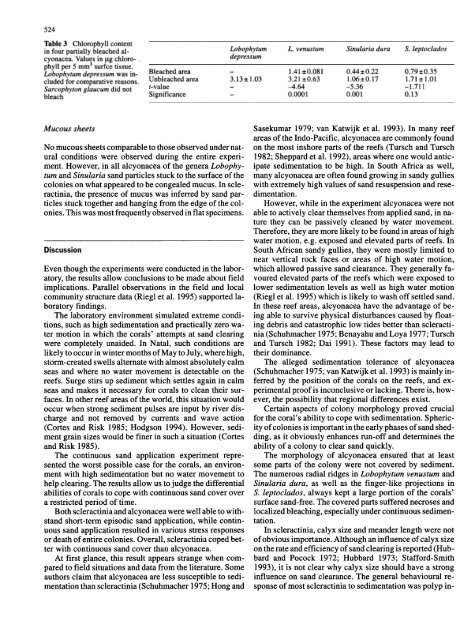Effects of sand deposition on scleractinian and alcyonacean corals
Effects of sand deposition on scleractinian and alcyonacean corals
Effects of sand deposition on scleractinian and alcyonacean corals
You also want an ePaper? Increase the reach of your titles
YUMPU automatically turns print PDFs into web optimized ePapers that Google loves.
:to.35:t<br />
524<br />
Table 3 Chlorophyll c<strong>on</strong>tent<br />
in four partially bleached alcy<strong>on</strong>acea.<br />
Values in I1g chlorophyll<br />
per 5 mm3 surfce tissue.<br />
Lobophytum depressum was included<br />
for comparative reas<strong>on</strong>s.<br />
Sarcophyt<strong>on</strong> glaucum did not<br />
bleach<br />
Bleached area<br />
Unbleached area<br />
I-value<br />
Significance<br />
Lobophytum<br />
depressum<br />
-<br />
3.13:t 1.03<br />
L. venustum<br />
1.41 :1:0.081<br />
3.21 :1:0.63<br />
-4.64<br />
0.0001<br />
Sinularia dura S. leptoclados<br />
0.44:t0.22<br />
1.06:t0.17<br />
-5.36<br />
0.001<br />
Mucous sheets<br />
Sasekumar 1979; van Katwijk et a1. 1993). In many reef<br />
areas <str<strong>on</strong>g>of</str<strong>on</strong>g> the Indo-Pacific, a1cy<strong>on</strong>acea are comm<strong>on</strong>ly found<br />
No mucous sheets comparable to those observed under nat- <strong>on</strong> the most inshore parts <str<strong>on</strong>g>of</str<strong>on</strong>g> the reefs (Tursch <strong>and</strong> Tursch<br />
ural c<strong>on</strong>diti<strong>on</strong>s were observed during the entire experi- 1982; Sheppard et a1. 1992), areas where <strong>on</strong>e would anticment.<br />
However, in all alcy<strong>on</strong>acea <str<strong>on</strong>g>of</str<strong>on</strong>g> the genera Lobophyipate sedimentati<strong>on</strong> to be high. In South Africa as well,<br />
tum <strong>and</strong> Sinularia <str<strong>on</strong>g>s<strong>and</strong></str<strong>on</strong>g> particles stuck to the surface <str<strong>on</strong>g>of</str<strong>on</strong>g> the many alcy<strong>on</strong>acea are <str<strong>on</strong>g>of</str<strong>on</strong>g>ten found growing in <str<strong>on</strong>g>s<strong>and</strong></str<strong>on</strong>g>y gullies<br />
col<strong>on</strong>ies <strong>on</strong> what appeared to be c<strong>on</strong>gealed mucus. In scle- with extremely high values <str<strong>on</strong>g>of</str<strong>on</strong>g> <str<strong>on</strong>g>s<strong>and</strong></str<strong>on</strong>g> resuspensi<strong>on</strong> <strong>and</strong> reseractinia,<br />
the presence <str<strong>on</strong>g>of</str<strong>on</strong>g> mucus was inferred by <str<strong>on</strong>g>s<strong>and</strong></str<strong>on</strong>g> pardimentati<strong>on</strong>.ticles stuck together <strong>and</strong> hanging from the edge <str<strong>on</strong>g>of</str<strong>on</strong>g> the col- However, while in the experiment alcy<strong>on</strong>acea were not<br />
<strong>on</strong>ies. This was most frequently observed in flat specimens. able to actively clear themselves from applied <str<strong>on</strong>g>s<strong>and</strong></str<strong>on</strong>g>, in nature<br />
they can be passively cleaned by water movement.<br />
Therefore, they are more likely to be found in areas <str<strong>on</strong>g>of</str<strong>on</strong>g> high<br />
water moti<strong>on</strong>, e.g. exposed <strong>and</strong> elevated parts <str<strong>on</strong>g>of</str<strong>on</strong>g> reefs. In<br />
Discussi<strong>on</strong><br />
South African <str<strong>on</strong>g>s<strong>and</strong></str<strong>on</strong>g>y gullies, they were mostly limited to<br />
near vertical rock faces or areas <str<strong>on</strong>g>of</str<strong>on</strong>g> high water moti<strong>on</strong>,<br />
Even though the experiments were c<strong>on</strong>ducted in the labor- which allowed passive <str<strong>on</strong>g>s<strong>and</strong></str<strong>on</strong>g> clearance. They generally faatory,<br />
the results allow c<strong>on</strong>clusi<strong>on</strong>s to be made about field voured elevated parts <str<strong>on</strong>g>of</str<strong>on</strong>g> the reefs which were exposed to<br />
implicati<strong>on</strong>s. Parallel observati<strong>on</strong>s in the field <strong>and</strong> local lower sedimentati<strong>on</strong> levels as well as high water moti<strong>on</strong><br />
community structure data (Riegl et al. 1995) supported la- (Riegl et al. 1995) which is likely to wash <str<strong>on</strong>g>of</str<strong>on</strong>g>f settled <str<strong>on</strong>g>s<strong>and</strong></str<strong>on</strong>g>.<br />
boratory findings.<br />
In these reef areas, alcy<strong>on</strong>acea have the advantage <str<strong>on</strong>g>of</str<strong>on</strong>g> be-<br />
The laboratory envir<strong>on</strong>ment simulated extreme c<strong>on</strong>diing able to survive physical disturbances caused by floatti<strong>on</strong>s,<br />
such as high sedimentati<strong>on</strong> <strong>and</strong> practically zero waing debris <strong>and</strong> catastrophic low tides better than scleractiter<br />
moti<strong>on</strong> in which the <strong>corals</strong>' attempts at <str<strong>on</strong>g>s<strong>and</strong></str<strong>on</strong>g> clearing nia (Schuhmacher 1975; Benayahu <strong>and</strong> Loya 1977; Tursch<br />
were completely unaided. In Natal, such c<strong>on</strong>diti<strong>on</strong>s are <strong>and</strong> Tursch 1982; Dai 1991). These factors may lead to<br />
likely to occur in winter m<strong>on</strong>ths <str<strong>on</strong>g>of</str<strong>on</strong>g> May to July, where high, their dominance.<br />
storm-created swells alternate with almost absolutely calm The alleged sedimentati<strong>on</strong> tolerance <str<strong>on</strong>g>of</str<strong>on</strong>g> alcy<strong>on</strong>acea<br />
seas <strong>and</strong> where no water movement is detectable <strong>on</strong> the (Schuhmacher 1975; van Katwijk et al. 1993) is mainly in-<br />
reefs. Surge stirs up sediment which settles again in calm ferred by the positi<strong>on</strong> <str<strong>on</strong>g>of</str<strong>on</strong>g> the <strong>corals</strong> <strong>on</strong> the reefs, <strong>and</strong> ex-<br />
seas <strong>and</strong> makes it necessary for <strong>corals</strong> to clean their surperimental pro<str<strong>on</strong>g>of</str<strong>on</strong>g> is inc<strong>on</strong>clusive or lacking. There is, howfaces.<br />
In other reef areas <str<strong>on</strong>g>of</str<strong>on</strong>g> the world, this situati<strong>on</strong> would ever, the possibility that regi<strong>on</strong>al differences exist.<br />
occur when str<strong>on</strong>g sediment pulses are input by river dis- Certain aspects <str<strong>on</strong>g>of</str<strong>on</strong>g> col<strong>on</strong>y morphology proved crucial<br />
charge <strong>and</strong> not removed by currents <strong>and</strong> wave acti<strong>on</strong> for the coral's ability to cope with sedimentati<strong>on</strong>. Spheric-<br />
(Cortes <strong>and</strong> Risk 1985; Hodgs<strong>on</strong> 1994). However, sediity <str<strong>on</strong>g>of</str<strong>on</strong>g> col<strong>on</strong>ies is important in the early phases <str<strong>on</strong>g>of</str<strong>on</strong>g> <str<strong>on</strong>g>s<strong>and</strong></str<strong>on</strong>g> shedment<br />
grain sizes would be finer in such a situati<strong>on</strong> (Cortes ding, as it obviously enhances run-<str<strong>on</strong>g>of</str<strong>on</strong>g>f <strong>and</strong> determines the<br />
<strong>and</strong> Risk 1985).<br />
ability <str<strong>on</strong>g>of</str<strong>on</strong>g> a col<strong>on</strong>y to clear <str<strong>on</strong>g>s<strong>and</strong></str<strong>on</strong>g> quickly.<br />
The c<strong>on</strong>tinuous <str<strong>on</strong>g>s<strong>and</strong></str<strong>on</strong>g> applicati<strong>on</strong> experiment repre- The morphology <str<strong>on</strong>g>of</str<strong>on</strong>g> alcy<strong>on</strong>acea ensured that at least<br />
sented the worst possible case for the <strong>corals</strong>, an envir<strong>on</strong>- some parts <str<strong>on</strong>g>of</str<strong>on</strong>g> the col<strong>on</strong>y were not covered by sediment.<br />
ment with high sedimentati<strong>on</strong> but no water movement to The numerous radial ridges in Lobophytum venustum <strong>and</strong><br />
help clearing. The results allow us to judge the differential Sinularia dura, as well as the finger-like projecti<strong>on</strong>s in<br />
abilities <str<strong>on</strong>g>of</str<strong>on</strong>g> <strong>corals</strong> to cope with c<strong>on</strong>tinuous <str<strong>on</strong>g>s<strong>and</strong></str<strong>on</strong>g> cover over S. leptoclados, always kept a large porti<strong>on</strong> <str<strong>on</strong>g>of</str<strong>on</strong>g> the <strong>corals</strong>'<br />
a restricted period <str<strong>on</strong>g>of</str<strong>on</strong>g> time.<br />
surface <str<strong>on</strong>g>s<strong>and</strong></str<strong>on</strong>g>-free. The covered parts suffered necroses <strong>and</strong><br />
Both scleractinia <strong>and</strong> alcy<strong>on</strong>acea were well able to with- localized bleaching, especially under c<strong>on</strong>tinuous sedimenst<strong>and</strong><br />
short-term episodic <str<strong>on</strong>g>s<strong>and</strong></str<strong>on</strong>g> applicati<strong>on</strong>, while c<strong>on</strong>tintati<strong>on</strong>.uous <str<strong>on</strong>g>s<strong>and</strong></str<strong>on</strong>g> applicati<strong>on</strong> resulted in various stress resp<strong>on</strong>ses In scleractinia, calyx size <strong>and</strong> me<strong>and</strong>er length were not<br />
or death <str<strong>on</strong>g>of</str<strong>on</strong>g> entire col<strong>on</strong>ies. Overall, scleractinia coped bet- <str<strong>on</strong>g>of</str<strong>on</strong>g> obvious importance. Although an influence <str<strong>on</strong>g>of</str<strong>on</strong>g> calyx size<br />
ter with c<strong>on</strong>tinuous <str<strong>on</strong>g>s<strong>and</strong></str<strong>on</strong>g> cover than alcy<strong>on</strong>acea. <strong>on</strong> the rate <strong>and</strong> efficiency <str<strong>on</strong>g>of</str<strong>on</strong>g> <str<strong>on</strong>g>s<strong>and</strong></str<strong>on</strong>g> clearing is reported (Hub-<br />
At first glance, this result appears strange when combard <strong>and</strong> Pocock 1972; Hubbard 1973; Stafford-Smith<br />
pared to field situati<strong>on</strong>s <strong>and</strong> data from the literature. Some 1993), it is not clear why calyx size should have a str<strong>on</strong>g<br />
authors claim that alcy<strong>on</strong>acea are less susceptible to sedi- influence <strong>on</strong> <str<strong>on</strong>g>s<strong>and</strong></str<strong>on</strong>g> clearance. The general behavioural rementati<strong>on</strong><br />
than scleractinia (Schuhmacher 1975; H<strong>on</strong>g <strong>and</strong> sp<strong>on</strong>se <str<strong>on</strong>g>of</str<strong>on</strong>g> most scleractinia to sedimentati<strong>on</strong> was polyp in-<br />
0.79<br />
1.71<br />
-1.7<br />
0.13<br />
1.0111
















